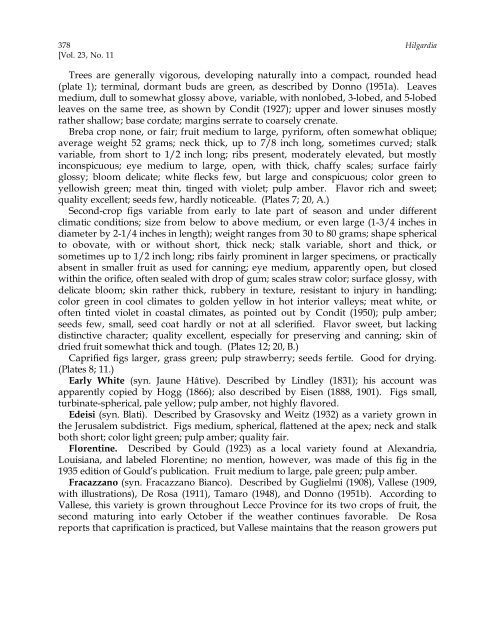Fig Varieties: A Monograph - uri=ucce.ucdavis
Fig Varieties: A Monograph - uri=ucce.ucdavis
Fig Varieties: A Monograph - uri=ucce.ucdavis
You also want an ePaper? Increase the reach of your titles
YUMPU automatically turns print PDFs into web optimized ePapers that Google loves.
378 Hilgardia<br />
[Vol. 23, No. 11<br />
Trees are generally vigorous, developing naturally into a compact, rounded head<br />
(plate 1); terminal, dormant buds are green, as described by Donno (1951a). Leaves<br />
medium, dull to somewhat glossy above, variable, with nonlobed, 3-lobed, and 5-lobed<br />
leaves on the same tree, as shown by Condit (1927); upper and lower sinuses mostly<br />
rather shallow; base cordate; margins serrate to coarsely crenate.<br />
Breba crop none, or fair; fruit medium to large, pyriform, often somewhat oblique;<br />
average weight 52 grams; neck thick, up to 7/8 inch long, sometimes curved; stalk<br />
variable, from short to 1/2 inch long; ribs present, moderately elevated, but mostly<br />
inconspicuous; eye medium to large, open, with thick, chaffy scales; surface fairly<br />
glossy; bloom delicate; white flecks few, but large and conspicuous; color green to<br />
yellowish green; meat thin, tinged with violet; pulp amber. Flavor rich and sweet;<br />
quality excellent; seeds few, hardly noticeable. (Plates 7; 20, A.)<br />
Second-crop figs variable from early to late part of season and under different<br />
climatic conditions; size from below to above medium, or even large (1-3/4 inches in<br />
diameter by 2-1/4 inches in length); weight ranges from 30 to 80 grams; shape spherical<br />
to obovate, with or without short, thick neck; stalk variable, short and thick, or<br />
sometimes up to 1/2 inch long; ribs fairly prominent in larger specimens, or practically<br />
absent in smaller fruit as used for canning; eye medium, apparently open, but closed<br />
within the orifice, often sealed with drop of gum; scales straw color; surface glossy, with<br />
delicate bloom; skin rather thick, rubbery in texture, resistant to injury in handling;<br />
color green in cool climates to golden yellow in hot interior valleys; meat white, or<br />
often tinted violet in coastal climates, as pointed out by Condit (1950); pulp amber;<br />
seeds few, small, seed coat hardly or not at all sclerified. Flavor sweet, but lacking<br />
distinctive character; quality excellent, especially for preserving and canning; skin of<br />
dried fruit somewhat thick and tough. (Plates 12; 20, B.)<br />
Caprified figs larger, grass green; pulp strawberry; seeds fertile. Good for drying.<br />
(Plates 8; 11.)<br />
Early White (syn. Jaune Hâtive). Described by Lindley (1831); his account was<br />
apparently copied by Hogg (1866); also described by Eisen (1888, 1901). <strong>Fig</strong>s small,<br />
turbinate-spherical, pale yellow; pulp amber, not highly flavored.<br />
Edeisi (syn. Blati). Described by Grasovsky and Weitz (1932) as a variety grown in<br />
the Jerusalem subdistrict. <strong>Fig</strong>s medium, spherical, flattened at the apex; neck and stalk<br />
both short; color light green; pulp amber; quality fair.<br />
Florentine. Described by Gould (1923) as a local variety found at Alexandria,<br />
Louisiana, and labeled Florentine; no mention, however, was made of this fig in the<br />
1935 edition of Gould’s publication. Fruit medium to large, pale green; pulp amber.<br />
Fracazzano (syn. Fracazzano Bianco). Described by Guglielmi (1908), Vallese (1909,<br />
with illustrations), De Rosa (1911), Tamaro (1948), and Donno (1951b). According to<br />
Vallese, this variety is grown throughout Lecce Province for its two crops of fruit, the<br />
second maturing into early October if the weather continues favorable. De Rosa<br />
reports that caprification is practiced, but Vallese maintains that the reason growers put
















![Fig Trees in North Carolina [Archive] - IDigMyGarden ... - Figs 4 Fun](https://img.yumpu.com/26905320/1/190x245/fig-trees-in-north-carolina-archive-idigmygarden-figs-4-fun.jpg?quality=85)